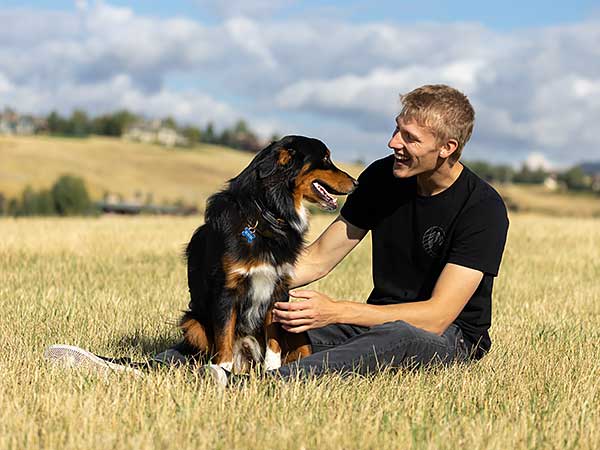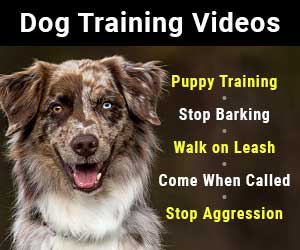
Methods of Dog Training: Finding What Works Best for You
There are many different methods of dog training. In fact, it is such a complex subject that it's easy for both you and your pup to become overwhelmed. This is actually one of the most common problems faced by dog owners. Whether your intent is to learn new behaviors or curb existing ones, in order to be successful you need to figure out which training technique, or combination, will work the best for you and your dog.
The main problem most dog owners face when it comes to choosing the right dog training methods is an overabundance of information. There are many trainers out there, touting the success of their method on TV and the internet. It can be easy to get swept up in these usually glowing testimonies and figure if it works for him, it will work for me.
That's a big mistake and one that can derail the success of your training before it even gets started. The fact is that, like their human counterparts, all dogs are different. Personalities and behavior differs from one dog to another, so what works for one dog won't necessarily work for them all. So your first step when selecting proper methods of dog training is to understand your dog and what makes him tick.
Match the Methods of Dog Training You Use to Your Needs
It would be easy to assume that you can just apply a training technique and be successful but that's not the case. In order for any of the many dog training methods to truly be successful you need to address the underlying cause of the behavior. Presenting a new set of conditions, whether positive or negative, without addressing the cause of the behavior will only be a temporary fix at best.
Of course, not all training is about curbing bad behavior. Sometimes the intent is to teach new skills or behaviors. Again, you need to find the method that will work best for your dog, to help him learn the skill smoothly and easily. Since each dog is an individual, you need to understand your dog's intelligence level and ability to learn new skills so you can figure out what works.
Some breeds are naturally quick and eager learners and the Australian Shepherd most definitely fits into that category. This doesn't guarantee that training will be easy, however. You still need to carefully choose from among the many methods of dog training so that you have the right form for your dog. Also, be aware that your Aussie is eager to please and will constantly be looking for new challenges, so combining techniques to keep things fresh make actually makes the most sense.
Dog Training Methods to Consider
So what exactly are the best dog training methods? Let's take a minute and consider them to help give you the building blocks of a successful training program:
Positive Reinforcement — This is the most common, and often most effective, form of training. The premise is a simple one: a dog will repeat a behavior if the behavior is followed by a reward. The good part of this method is that it can be used for both behavioral training and skill training. The challenge is that it requires consistency and must be adhered to by every member of the family in order to be successful. In order for positive reinforcement to work, the reward, usually a treat, toy, praise, or pets, must be given within a half a second of the behavior being displayed. That way the dog will associate the behavior with the positive result.
Unfortunately, while this is one of the most successful methods of dog training, it can also be easy to get it wrong. Everyone has to be on the same page and you must be sure to only reward good behavior so that your signals don't get crossed.
Science Based Training — Among all of the dog training methods, this is easily the most complex and difficult for the average dog owner to understand. That's because scientists base their training methods on dog psychology and their training in this area is constantly evolving and changing, so the training methods tend to change with it.
For the most part, scientific training revolves around two basic theories: Operant Conditioning and Classical Conditioning. Operant conditioning is basically trial and error learning. As with positive reinforcement, good behaviors are rewarded and in this case bad behaviors are deterred with some form of punishment. Both reinforcement and punishment can be positive or negative, meaning you either add something to the situation or take something away.
Check out these introductory dog training videos...
The other form of scientific training is Classical Conditioning. This is also called Pavlovian conditioning, named for psychologist Ivan Pavlov, who in 1897 was able to determine a connection between stimuli and emotional states. By rewarding a dog after the sound of a buzzer, Pavlov was then able to observe a specific emotional response in the dog (salivating, panting, alerting) at the sound of the buzzer as the dog equated the sound with a positive experience.
For the most part, science based training incorporates many of the same principles found in the other methods of dog training. It may be challenging for the average dog owner but it's still important to at least consider scientific training as in many ways it forms the building blocks of all other training methods.
Clicker Training — One of the most common, and generally most successful, dog training methods for obedience and skill training, clicker training, takes positive reinforcement one step further by associating the reward with a sound. A trainer can use a quick sharp sound, from a whistle or a clicker, immediately after a wanted behavior and then follow it immediately with a treat. The advantage of this training method is that it signals the precise moment the wanted behavior is completed so the dog is aware of exactly what is being rewarded. In many cases, this can help him to learn quicker. It can also be incorporated with verbal commands to help him learn more complex skills.
Electronic Training — This is one of the more controversial methods of dog training as it relies on the principle of negative reinforcement. In this case the dog is fitted with a special collar that delivers an electric shock when an unwanted behavior is displayed. This technique is used for everything from boundary training with an electric fence to curbing aggressive behavior or resource guarding.
Many modern electronic training collars allow for very low settings that provide more of a tingle than a shock. Some models also allow for an audible tone and vibration option. So, it's not reasonable to dismiss all uses of so-called "shock collars" as abusive. Of course, the less the stimulus provided by the collar, the more likely it is to be ignored by your dog. However, unless you really know what you are doing, you should get professional guidance or find an alternative training approach.
Use of Collars That Inflict Pain Are Likely to Cause More Harm Than Good
While it may be effective in some cases, most trainers and many dog owners are reluctant to use this method because it can too easily go wrong. If the punishment is doled out too frequently, the dog may become anxious, which can actually lead to even worse behavior. At the same time, unlike other dog training methods, this method has a tendency to leave the dog with mixed signals, understanding what he shouldn't do but not knowing exactly what it is he should do.
In addition to electronic collars, which can have settings that deliver what would be considered a painful shock, there are other types of collars that can also cause pain. These include choke collars and collars with metal or plastic prongs intended to inflict pain. However, using these methods can be seen as cruel and can easily cross the line from discipline to abuse when not applied properly. Even professional dog trainers only use this approach with certain dogs, for specific reasons and most dog owners don't have the requisite knowledge or experience to use them appropriately or safely.
More Types of Dog Training
Mirror Training — This is one of the more unique methods of dog training, based on the principle that dogs learn by observation. The theory here is that if the dog witnesses good behavior in a model, it will mimic that same behavior. This can be used in concert with a professional trainer, with the owner acting as the model, or with multiple members of a family, with one teaching and one acting as the model. The trainer simply issues the command to the model, who obeys and is rewarded, and the dog will realize that the same response from him will result in the same reward. This can also be a great way to reinforce the bond between dog and owner.
Dominance Training — This is another of the more controversial methods of dog training. It originated in the 1940's and is based on the theory that modern domestic dogs, like their wild ancestors, see their families as packs and follow a social hierarchy. Dog trainers then asserted that in order to have an obedient dog you need to establish yourself as the head of the pack and ensure that your dog submits to you.
The theory gained popularity with trainers such as Cesar Milan, who actually combines dominance training with other training techniques to achieve the best results. Over the years, critics have contended that the original idea of a "pack mentality" is actually not true and that this method is not as effective as once thought. In fact, since it fails to address the underlying cause of unwanted behavior, dominance training can leave dogs feeling stressed and anxious and can undermine the dog/owner bond.
The Phrase "Pack Leader" Is Not the Problem. It's How It Is Interpreted...
It is important not to dismiss a training approach just because it uses the phrase "pack leader". This simply denotes that there is a hierarchy. That doesn't mean that the hierarchy is necessarily enforced with dominance or abuse. It could be quite the opposite.
For example, a highly recommended online dog training program created by the professional dog trainer from New Zealand, known as "Doggy Dan", uses the concept of "pack leader". However, he emphasizes the importance of being regarded by your dog as a respected leader so they look to you for guidance. This is far different than using intimidation or fear to manipulate your dog.
In the same way, a boss at a company can lead by threats and intimidation or they can lead by inpiring their team to succeed as a respected leader.
If you are looking for a cost-effective, positive approach to dog training that covers everything from obedience training to just about any behavior problem you are likely to come across, you can find out more about Dan's program here.
Relationship-based Training — Though it combines several different training concepts, this is actually one of the most individualized dog training methods. As the name suggests, it is based on the idea that the relationship between dog and owner drives all learning. In this method, you must be aware of your dog's body language, what motivates him best and how to meet his basic needs. With this in mind, you'll be able to tailor your training method to get the best result from your dog.
Relationship-based training uses positive reinforcement to encourage good behaviors but avoids the use of punishment to control unwanted behavior. Instead, you can prevent unwanted behavior by controlling the dog's environment, starting the learning process in a quiet location where the dog can focus on you before graduating to areas that have more external stimulants.
Unlike other methods of dog training, the point of relationship-based training is to understand why the dog isn't performing the required behavior or is exhibiting an unwanted behavior and address that underlying cause. This can help the dog to avoid developing associated stress and can actually deepen the dog/owner bond as you work together to achieve the ultimate results.

Dylan / stock.adobe.com
Sometimes the best method for training your dog will arise out of the relationship and strong bond you have.
Which Method of Dog Training or Combination Works Best for You?
Now that you understand the various dog training methods, the key is trying them on for size and figuring out which method, or more likely combination of methods, works best for you and your dog. You'll probably need a lot of trial and error before you settle into a routine that suits both of you and gives you the results you're looking for, so be patient and don't get discouraged. If you get stressed out over training, that feeling is likely to be passed on to your dog, which won't help either of you.

Start with our official ebook Guide To Australian Shepherd Training & Care. It was created by Aussie lovers for Aussie lovers. You can read this practical guide on any computer, tablet, or smartphone.
Whether you're interested in obedience training or you want to teach your dog a new skill, the ultimate result is to have a happy, well-adjusted dog and to create a strong and loving bond between dog and owner. It's not about showing him who's boss but rather using leverage, such as treats and other rewards, to encourage the proper behavior.
It's also worth remembering that for any dog one of the most potent forms of reward is the love of his owner. Never underestimate the power of an encouraging word or a pat on the head. That is especially true for Australian Shepherds, who are extremely eager to please their owners. The right response from you can go a long way toward achieving the results you want, eventually ending with a happy, satisfied dog and owner.
Before you jump into training head first, take the time to consider all of the different methods of dog training and find the right approach for you and your dog. If you're unsure of which way to go, consult with your vet or a professional trainer for advice. The choice you make can have a significant impact on your relationship with your dog so it's something you need to take very seriously.
Check out these introductory dog training videos...
Have Dog Training Questions?
Check out these introductory dog training videos...
I want my dog to stop being aggressive.
I want some help training my new puppy.
I want my dog to stop barking at everything.
Get Australian Shepherd Info, Website Updates, Special Offers, and Cartoons...
FREE GIFT
You'll also receive a free copy of the ebook
My Everyday Dog Training Tools
by professional dog trainer Daniel Abdelnoor, "Doggy Dan"















 Loading Image...
Loading Image...